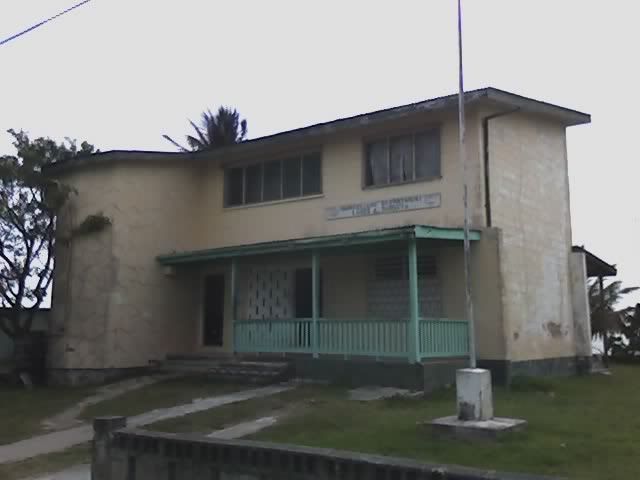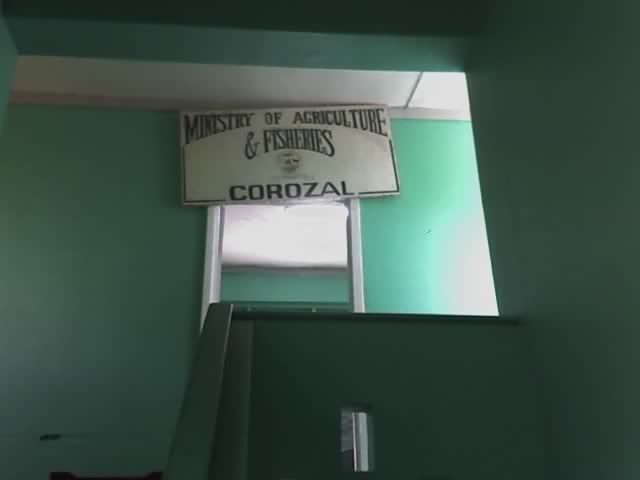Yes, they grow corn here. In fact, corn was invented here, or near here.
Corn is important here, but before I made bold authoritative statements, I thought I would go for a walk and get some expert, credentialed information regarding corn in Belize. Especially since the lady who asked probably knows more about corn than I will ever know.
So, I wandered along the sea to the Lands Office.

Upstairs from the Land and Survey office is the Ministry of Agriculture. I figured they might be able tell me about corn or maize in Belize.

Arriving at the office of the Corozal branch of the Ministry, I meet a man who seemed very pleased to tell me all about corn in Belize. I asked when was the right time to plant corn here, and he said that with irrigation, corn is planted all year round. Without irrigation, corn is generally planted right now, in early May. Specifically, it is planted when the rainy season has begun, as indicated by the second rain storm. The hybrid varieties of corn generally take about three months to mature, and even if reliant on the rains, most farmers can get a second crop in.
I have no pictures of corn fields. I have seen a few here, most are small, planted by hand. Large garden scale rather than farm field scale, although the Mennonites probably have some significant corn fields. Even if I could post some pictures of local corn, I don't think I would.
Even though corn was domesticated here and this is the place of origin for corn, corn grows better in places like Ohio, Indiana, Illinois, and Iowa. Almost every time I see a plot of corn here I am slightly shocked by comparing to my memories of the lush, tall and green cornfields of Ohio and Indiana.
So, I am not going to go to great lengths to find pictures of local corn. I can't help but think any farmer from the American Midwest would weep and cry out, "oh those poor poor people, look at the state of their corn". Nevertheless, they plant corn and it does produce here, though certainly not as much as Ohioans are used to.
The importance of maize to the culture is astounding, both in the past and presently. Though the ancient meso-americans domesticated and developed corn themselves, they credited their gods with the accomplishment. But maize is of greater importance than this. The gods the ancients believed in created the world without problems, the creation of humanity however was fraught with difficulty. The first attempt at humanity was made of earth, however the result was unsatisfactory to the gods, so that version of humanity was broken up and destroyed. The next version of humanity was made of wood, but this also was not sufficient, and that version was destroyed in a deluge. It was not until the gods fashioned men and women from corn that a viable version of humanity was achieved.
After that they began to talk about the creation and the making of our first mother and father; of yellow corn and of white corn they made their flesh; of corn meal dough they made the arms and the legs of man. Only dough of corn meal went into the flesh of our first fathers, the four men, who were created. Part 3, Chapter 1 of the Popol Vuh
In modern times, corn still holds an integral role in the culture.
And there is plenty of corn to grind. There's corn everywhere.
Corn for the masa tamales are boiled with cal until soft then it is ground up to be used as masa. The corn used in the collado tamales, however, is very hard as it is not cooked beforehand. New corn mills have been bought for the occasion. It is the men mostly, who take on this difficult task of grinding the crude corn...twice.
It will be another four hours before this corn is ready to be strained and the resulting corn milk is boiled down in huge pots that sit on open fires all around the yard. It is from this milk, the pure essence of the corn, that the masa for collado tamales are made. - SIMPLY BELIZE: A Cultural Diary EPISODE: # 1 - Yucatec Maya
There is a lot more I could write about. For instance the Cal mentioned in the excerpt is lime or calcium hydroxide. It is part of the nixtamalization process.
When maize was first introduced into other farming systems than those used by traditional native-American peoples, it was generally welcomed with enthusiasm for its productivity. However, a widespread problem of malnutrition soon arose wherever maize was introduced as a staple. This was a mystery since these types of malnutrition were not normally seen among the indigenous Americans, to whom maize was the principal staple food.[14]
It was eventually discovered that the indigenous Americans learned long ago to soak maize in alkali-water—made with ashes by North Americans and lime (calcium oxide) by Mesoamericans—which liberates the B-vitamin niacin, the lack of which was the underlying cause of the condition known as pellagra. This alkali process is known by its Nahuatl (Aztec)-derived name: nixtamalization.
Besides the lack of niacin, pellagra was also characterized by protein deficiency, a result of the inherent lack of two key amino acids in pre-modern maize, lysine and tryptophan. Nixtamalisation was also found to increase the availability of lysine and tryptophan to some extent, but more importantly, the indigenous Americans had learned long ago to balance their consumption of maize with beans and other protein sources such as amaranth and chia, as well as meat and fish, in order to acquire the complete range of amino acids for normal protein synthesis.
Since maize had been introduced into the diet of non-indigenous Americans without the necessary cultural knowledge acquired over thousands of years in the Americas, the reliance on maize in other cultures was often tragic. - Maize From Wikipedia, the free encyclopedia
Anyway, I might go on too long about corn. In answer to the other questions:
At first we will probably have a small electric pump and use the generator to run it to fill a big plastic cistern. Later, we will want a windmill. There is sufficient wind, however I may have to cut some brush. I want to try to make the windmill, but the Mennonites make and sell windmill / water pump sets.
The well is not really finished yet, just at a stage where we can get water to mix concrete. We have smelled the water, but didn't taste it. Eventually we will throw some cal or lime down there to clear the water, then some bleach to kill germs. The Ministry of Human Development will apparently test well water as will the hospital.
The real problem will be that we will not really trust that water for consumption for the next two years. I think the geology here is what is called karst and the water can move through the aquifer faster than it can be purified by the earth. Also, the field next door is being leased to the papaya company for two years, and they use enough pesticides and herbicides that even here in a "lesser developed nation" people are alarmed by possible contamination from their operations. We are not downwind of them, but still it is something in the back of our minds as we might well be down-aquifer of them. I may ask for a list of the chemicals that they use and then just search on the internet to see how bad they are. Belizeans are in some cases wildly environmentally conscious and they may be overly concerned about all the "chemics".
I have spoken with an engineer from the papaya company and they seem to want to be really good neighbors. I am under the impression that I am in a position to cause them some significant inconvenience, however, I want to be a good neighbor too. If not for their sake, then at least the man they are renting the field from. My understanding is that they will not lease that field from him again if people are living adjacent to it. Besides, it probably is not wise to try to push a Central American fruit company against a wall. I have heard stories about the behavior of Cincinnati's own Chiquita Brands in nearby countries.
This is not as great an inconvenience as it seems. For more than half a year we should easily be able to keep a cistern filled with rain water. And for the past three years we have been drinking bottled water. It is $1 for 5 gallons. The city water, or pipe water as it is called is more than safe, however it has a faint sulfur, salty, mineral taste and though we have tried to get used to it, we haven't. So we may continue with bottled water for drinking during the dry season. After two years, the papaya company will go somewhere else. Some papaya virus builds up in the fields and they can't get the intense productivity that they need.
What we really want the well for is irrigation, and it will probably be insufficient for that beyond a very small scale. But I don't know what is meant by small scale. It is possible that we would never do anything more than "small scale". When I ask people how big is small scale, I am told, it depends on what I want to grow, how I grow it, ground cover etc. The well could be sufficient for our needs and for a few hundred dollars I can find out.
If it isn't sufficient, I have been told that the Ministry of Human Development is currently drilling 100ft wells for free provided that the owner of the well pay for the pipe and the diesel fuel used during drilling. It was described to me as a make work program, but in any case if it is true, that may be our best long term option. Worst case, the Mennonites will drill a 100 ft well for about $2000, though if a deep well is needed, I hope to find a cheaper way.
1 comment:
John
I am so happy to be able to read your additions to your blog again!!! Dad and I both enjoy them. We hope to catch up on all your additions. It will be awhile as I am subbing a lot lately. That and gardening and other obligations has us constantly busy.
It is such a treat for us to read your blogs as they are so interesting and keeps us informed about your actiivities.
As regards the corn - you know I was raised on a farm and my Dad planted a lot of corn which grew very tall and yielded many ears.
I don't remember how many bushels he got per acre but it was a lot.
The next time we get up to Delphos
I'll ask. We lived in an ideal location with rich soil and ample rainfall and hot, muggy nights.
The well information was interesting too
Post a Comment